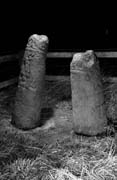Select a site alphabetically from the choices shown in the box below. Alternatively, browse sculptural examples using the Forward/Back buttons.
Chapters for this volume, along with copies of original in-text images, are available here.
Object type: Double socket-stone [1]
Measurements: L. 160 cm (33 in); W. 116 cm (45 in); H. not known. Diameter of west socket c. 52 cm (20.5 in); of east socket c. 51 cm (20 in); socket depth 28 cm (11 in), according to Lysons (1810, 459), though Marshall (1975, 69) claims 'five to six inches' (c. 13 to 15 cm).
Stone type: As Disley (Lyme Handley) 1 and 2 above, but some scattered quartz pebbles up to 8.0 mm
Plate numbers in printed volume: Ill. 162
Corpus volume reference: Vol 9 p. 79-80
(There may be more views or larger images available for this item. Click on the thumbnail image to view.)
The flat-topped, irregularly shaped (sub-oval) stone carries two sockets, now holding the round-shafts nos. 1 and 2. The stone has no visible decoration.
Double socket for round-shafts (see Chapter V, pp. 37–8, and Disley Church Field 1, p. 73, Ills. 160–1). There is some doubt as to whether this socket originally carried the shafts now set in it (see Disley Lyme Handley 1 above, p. 78). Marshall (1975, 69) claimed that the whole stone was only five to six inches in depth and thus incapable of holding a complete cruciform monument; against this the Lysons measured the socket depth as eleven inches, which would be perfectly adequate depth for this purpose. The Macclesfield Courier for 29 May 1858 carries a letter from 'An Antiquarian': 'I myself was present when Mr Legh of Lyme allowed the double cross at Bow Stone Farm to be excavated. A trench was dug beneath its broad basal socket sufficiently deep to enable me and others to walk beneath it'; Renaud (1876, 73) also notes this. Unfortunately the writer does not record the depth of the stone, which is critical to the case for its being the original socket for shafts nos. 1 and 2.



